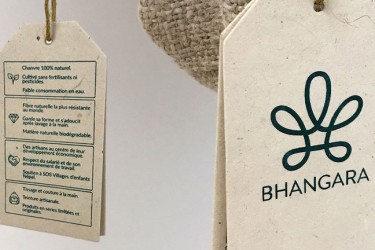How to reconcile design and eco-responsible values ?
When you decide to create a brand of any kind, you don't realize the scope of the work at first glance. And if it's an ethical brand driven by respect for human and environmental values, even more issues must be considered. What appears as details at the beginning, is no longer so afterwards. Scale up the aspects, weigh the pros and cons, measure the impact of each decision, question the feasibility... all of that while maintaining a creative line.
What’s this type of paper?
Lokta. Our label, this small piece of paper, has come a long way in our heads before reaching you. First of all, we chose it because it is made of an eco-friendly natural fiber, because of its great resistance, fancy appearance, and visible quality.
Lokta fiber comes from the bark of shrubs that grow in eastern Nepal (between 1,600 m and 4,000 m); the arid climate that predominates there probably explains its hardiness. Once harvested by hand, the barks regenerate completely after 4 to 8 years.
Its usage dates back to the first Tibetan manuscripts. Lokta paper is used nowadays to write sacred texts and official information in Nepal. This paper has a widely recognized value and resists time, mould and insects. Once it´s manufactured, it can last thousands of years! It also can be woven and transformed into well-known Buddhist prayer flags or traditional clothing.
Processed in an artisanal way, the barks are crushed, soaked in water, boiled, and macerated until a paste is obtained. This is the way lokta paper is created.
After the choice, the doubt
Today, lokta paper is famous in the world of creative hobbies: cardboard, origami, decoration... At a time where initiatives are more and more looking for sustainable production -and that's good!- and when "green" has such a fashion effect, lokta paper is nowadays widely used.
New doubts arise in spite of the initial certainty. If lokta paper, Nepalese traditional paper, is used so much, don't we risk participating in an irresponsible and destructive exploitation? What is the impact of high production on the Himalayan highlands? What could be the consequences and transformation on a culture that is still artisanal?
Assessment and production context of our lokta paper
There were many questions that led us to investigate to be sure we made the right choice and, if necessary, be able to redirect our research.
Production quantity
Today, there would be 600 production units registered in Nepal. According to the Nepalese Department of Cottages and Small Industries, a third of them would already produce 30,000 tons per year and would experience a significant annual increase of close to 15%. However, this same source tells us that there are many untapped resources. There are still many plots of lokta shrubs at high altitude that are not cultivated for paper production. On the other hand, the raw material harvested for lokta paper is the bark. Bark regenerates after 4 to 8 years, as opposed to production of other paper fibers that results in deforestation.
Responsible manufacturing

After having investigated on the spot, we now know that to be able to meet the demand, there are less artisanal workshops in Kathmandu, that is, now most of them use mechanized manufacturing. However, the vast majority of paper production is still done in the Himalayan mountains, in rural areas, away from the big cities.
There, the production is still done by hand and is of high quality. The inhabitants, mostly women, take care of the crops and their handicraft heritage. Lokta shrubs thus ensure the income of families in their environment and enables them to provide for their needs. Lokta's dyeing and printing workshops provide a living for the city families. Here, our concern for the environment is combined with a more ethical aim which is, assisting the Nepalese people in becoming managers of their own economy.
Aware of the economic development challenges of these families, a good number of European and international structures use fair trade distribution networks, such as the Lamali brand for professionals, or obtain their own fair trade label. As for the Nepalese government, it strives to take care of the regulation of the exploitation of Lokta and regularly analyzes the situations of the small industries and paper mills.
Our labels
In short, lokta paper won our hearts because of its history and importance in Nepal and Tibet, as well as its rough and authentic texture. Lokta and hemp also share a wide range of properties. Both natural fibers are traditional, resistant, have been used for thousands of years, require little water, are self-sufficient in the monsoon climate and allow us to create beautiful and sustainable designs.
Now you know it. No matter what you order on our website : a handbag, a backpack, a purse… Don’t miss checking out its label. It’s not an everyday label.

